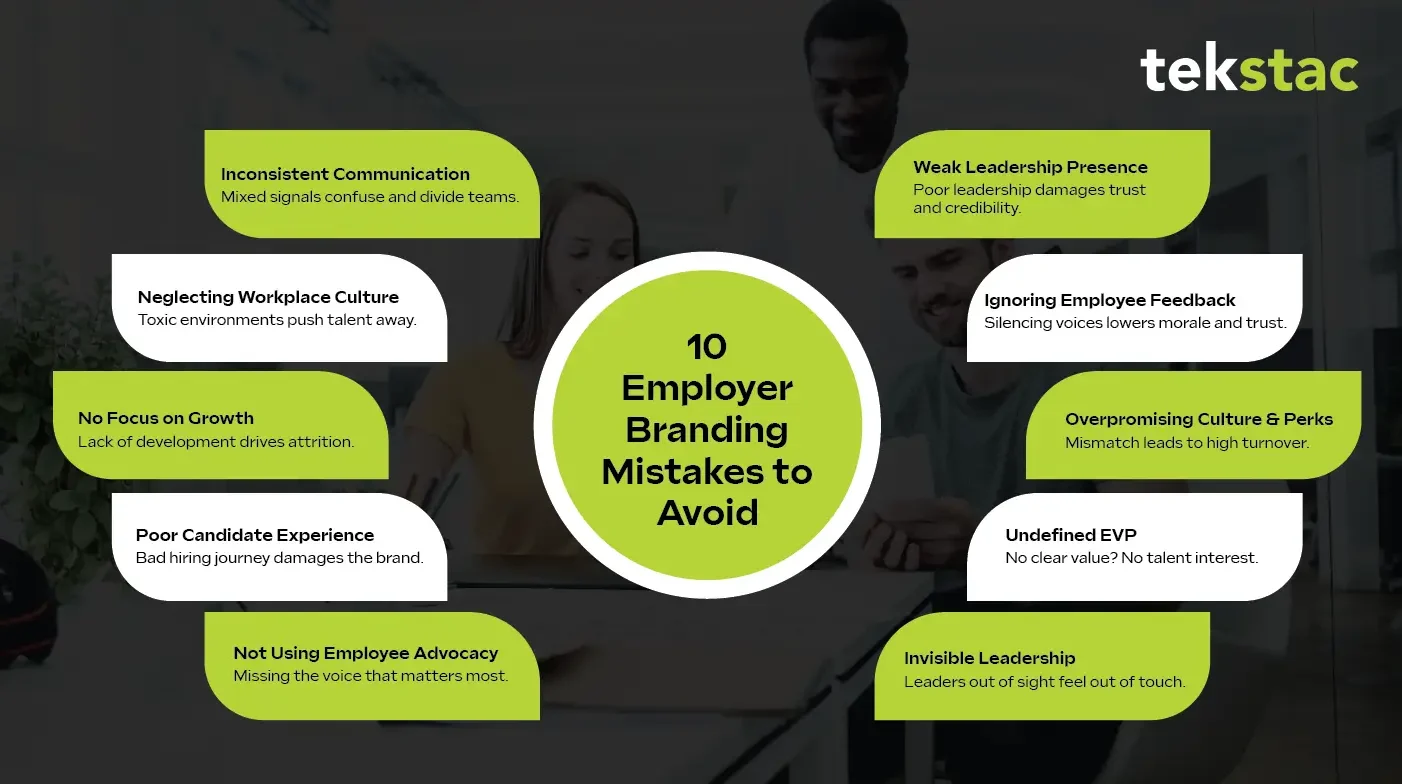10 Employer Branding Mistakes to Avoid in 2025

Imagine building your dream house, where every brick, wall, and window bears your aspirations. Now, suppose the foundation has cracked because of one tiny, overlooked mistake – collapse the entire structure of the house. Similarly employer branding functions act as the core reputation of your organization. It defines how your organization is perceived by both existing and potential employees. A well-developed employer brand not only attracts talent but it also shows the values, culture, and leadership effectiveness.
Even well-intentioned efforts can fail due to commonly overlooked mistakes. Much like a cracked foundation compromises the stability of a house, these common failures can undermine your efforts to win and retain top talent. In 2025, as the competition for talent intensifies, avoiding these mistakes will be more important than ever. This article delves into the top 10 employer branding mistakes to avoid and offers actionable insights to help you strengthen your brand’s foundation.
Employer Branding Mistakes to Avoid and How to Address Them
1. Neglecting Leadership Competence
Leadership competence is actually the backbone of any strong employer brand. The lack of trust, unclear communication, and lack of vision lead to poor leadership. Employees seek inspiration, vision, and authenticity from leaders. If these qualities are missing, it makes the organization look disorganized and unreliable to both employees and potential candidates.
Incompetence in leadership often tells of poor decision-making, lack of transparency, and disengagement from the workforce. This has led to dissatisfaction and mistrust culture within the organizations.
How to address it:
- Develop leadership development programs that focus on improving decision-making, communication, and emotional intelligence skills.
- Implement a feedback loop where leaders are regularly evaluated and provided with opportunities for growth.
- Ensure that leaders uphold the company’s mission and core values, making them role models for employees to emulate.

2. Failure to listen to employee feedback
Employee feedback is a valuable compass that can guide an organization toward improvement. Not listening to the voices of employees is like ignoring warning signs on a treacherous path. Failure to heed the inner voice of employees makes morale decline, erodes trust, and your employer brand suffers. In time, it comes with enormous turnover rates as well as a difficulty in acquiring the best talent.
Organizations often fail to construct effective feedback mechanisms or even to act on what they hear in the feedback. The lack of follow-up lets everyone know that the opinions of the employees do not matter.
How to address it:
- Create several channels of feedback, including anonymous surveys, town hall forums, and individual meetings, to make employees feel heard.
- Respond appropriately to the concerns raised in feedback by taking immediate action and explaining clearly about non-feasible changes.
- Encourage an environment where positive criticism is appreciated. Ensure employees should notice possible changes based on their suggestions with an atmosphere of trust and inclusiveness.
3. Overpromising and Under Delivering
Overselling the workplace culture or benefits in recruitment materials may initially attract candidates but often backfires. When the actual experience doesn’t match expectations, trust erodes, and retention rates drop. For example a Glassdoor study found that 58% of employees would not work for a company with a bad reputation, even if it meant a pay cut. This mismatch harms your employer brand and creates a disillusionment cycle with new hires. When employees are let down by what really exists in company culture, they will be more apt to leave, resulting in more turnover and additional recruitment costs.
Often organizations exaggerate some of their strength or overdo the polishing of an image that is way off from the real picture. Such tendencies will result in dissatisfaction and spoil your reputation.
How to Address It:
- Be transparent and authentic in your messaging. Highlight your strengths while being honest about areas of improvement.
- Involve current employees in creating recruitment content to ensure it accurately reflects the work environment.
- Review and update branding materials regularly to ensure they are in line with the current culture and practices of the organization.
4. Lack of clear definition of your EVP
The Employer Value Proposition (EVP) describes what makes your organization special and why people should work for you. An undefined or generic EVP leaves your employer brand without direction or identity. Without a clear and compelling EVP, potential candidates may fail to see the value your organization offers compared to competitors.
A good EVP reflects your culture, mission, and business goals while resonating with the needs and aspirations of your employees.
How to address it:
- Work with your employees to find out what they would value most from working at your organization.
- Align your EVP with the core values, mission, and vision of your organization to ensure consistency.
- Communicate your EVP clearly across all platforms, from job postings to social media, to resonate with your target audience.
5. Invisibility of Leadership
The invisibility of leadership contributes to a lack of trust and engagement within an organization. The lack of accessibility and engagement from leaders gives an impression of being unattached to employees. Lack of visibility may also weaken employees’ attachment to the mission and values of the organization.
Confident and responsible leaders build confidence. Leaders are not detached; they participate in activities within the workplace. They demonstrate that they are concerned with the success of the organization.
How to address it:
- Motivate the leaders to communicate with the staff more often through various meetings, updates, and informal contact.
- An open-door policy that makes leadership responsive and transparent to employees.
- Highlight what leaders have been doing in cultural and strategic ways to infuse ownership into the workforce.
6. Inconsistent Communication
Confusion among employees and candidates occurs from inconsistent communication. Mixed messages, or the failure to make it clear, do not promote trust and thus undermine alignment in teams and departments. Clear and consistent communication can provide a united vision and give employees confidence.
One of the toughest challenges in communication is trying to present cohesive messaging when changes occur or are unsure. Such a lack of consistency undermines the employer brand.
How to Address It:
- Develop a single communication strategy that ensures regular and transparent updates.
- Train leaders and managers to deliver consistent messaging that aligns with organizational goals.
- Use communication tools and technology to streamline internal and external communication efforts.
7. Ignoring Workplace Culture
Any organization’s heartbeat is its workplace culture. The best employer branding will be undone by a toxic or neglected culture. Employees want an environment that promotes inclusivity, collaboration, and respect. Not building a good workplace culture leads to low morale, high turnover, and damage to reputation.
A strong culture not only pulls in the talent but also bonds the existing one.
How to Address It:
- Regularly assess the workplace culture with surveys, focus groups, and feedback sessions.
- Promote DEI activities such as mentorship programs, bias training, and employee resource groups to create inclusivity and cater to diverse employees.
- Honor achievements and milestones to strengthen the sense of community and belonging.
8. Lack of Investment in Employee Development
Employees will remain loyal to the organization that develops them professionally. Neglecting employee development conveys a message to employees that the organization is not interested in their future and therefore results in a higher rate of turnover.
Without opportunities for growth, an organization is limited in its capacity to innovate and adjust to changes in the market.
How to address it:
- Train, hold workshops, and have mentors who help the employee grow professionally.
- Offer clear career development routes to help motivate and keep employees.
- Communicate your employee development focus internally via HR, internal communications, and also through external communications.
9. Neglect of candidate experience
Hiring is a candidate’s first touch point when engaging with your organization. Failure to engage well leads to top talent not being attracted and the loss of your employer’s brand. In essence, long hiring processes, inadequate clarification of some matters, or merely a cold response can move a candidate away.
A positive candidate experience not only makes your company look good, but also increases the chances of drawing top talent. According to fact, 72% of job applicants report that they would view a company more positively if they have a positive candidate experience throughout the hiring process.
How to address it:
- Simplify and streamline the hiring process to make it efficient and candidate-friendly.
- Ensure clear communication and proper updates throughout the recruitment journey.
- Train hiring managers to conduct respectful and engaging interviews that reflect the organization’s values and culture.
10. Failure to Leverage Employee Advocacy
Your most potent internal ambassadors are your employees. Not focusing on their role as promoters of your employer brand amounts to a lost opportunity in the strengthening of your reputation. Happy workers instinctively advocate for their workplace and help attract top talent while building morale.
Employee advocacy builds trust and authenticity and helps make your employer brand more believable and appealing.
How to address it:
- Encourage testimonials by employees and promote them on social media posts by your employees.
- Recognize and publicly celebrate employee achievements to instill pride and advocacy.
- Create an organizational culture that organically makes employees want to promote your brand.
Conclusion
Employer branding is not a strategy; it’s the bridge that brings your company’s values to the world. Avoiding these 10 mistakes will help your employer brand not just survive, but truly thrive in 2025 and beyond. Authenticity, transparent communication, and leadership competence will form a brand that resonates both with employees and candidates. Nurturing this foundation and avoiding pitfalls will attract top talent and a workplace where employees are valued. Start your employer brand today—create a brand that draws in and holds the right people for long-term success.





